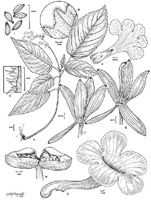
Cremersia patula Feuillet & L.E.Skog, type species
Brittonia 54 (2003), line drawing by Cathy Pasquale, orig. illustration
Full name and orig. publication: Cremersia C.Feuillet & L.E.Skog, Brittonia 54: 347 (16 Apr. 2003, “Oct.–Dec. 2002”).
Etymology: Named for Georges Cremers, a botanist collecting in French Guiana in the late 1970s.
Synonyms: -
Infrafamilial position: Gesnerioid Gesneriaceae (Gesnerioideae) - tribal position uncertain (Episcieae?).
Description: Terrestrial, caulescent herbs. Leaves opposite, petiolate, ovate-elliptic, venation pinnate, stomata scattered. Cymes axillary, pedunculate, bracteolate, flowers pedicellate. Sepals 5, free to base. Corolla salverform, bilabiate, 5-lobed. Stamens 4, included, filaments adnate to the corolla base, anthers cohering in a tetrad, thecae dehiscing by longitudinal slits. Nectary annular with a dorsal gland. Ovary superior, style bent at apex, stigma capitate. Fruit a dry, bivalved capsule, dehiscing loculicidally, opening to 180°, seeds with short, thick funicles.
Chromosome number: Unknown.
Type and only species: Cremersia platula C.Feuillet & L.E.Skog
Species names (incl. publication and synonyms): See Skog, L.E. & J.K. Boggan. 2005: World checklist of Gesneriaceae: http://persoon.si.edu/Gesneriaceae/Checklist.
Distribution: French Guiana.
Ecology: Terrestrial forest herb.
Notes: Tribal placement is difficult, the best placement is perhaps in Episcieae. Several characters are shared with Rhoogeton, a genus also difficult to place.
Bibliography: See Skog, L.E. & J.K. Boggan. 2005. Bibliography of the Gesneriaceae. 2nd edition: http://persoon.si.edu/Gesneriaceae/Bibliography.
Illustrations:
 |
Cremersia patula Feuillet & L.E.Skog, type species Brittonia 54 (2003), line drawing by Cathy Pasquale, orig. illustration |
last modified: 2007-07-13